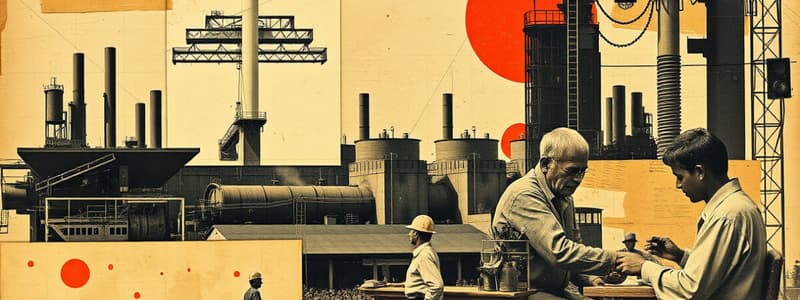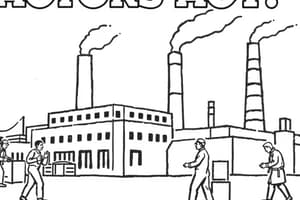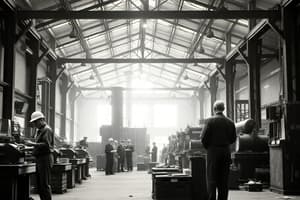Podcast
Questions and Answers
Which section of the Factories Act 1948 requires every dangerous machinery in a factory to be securely fenced?
Which section of the Factories Act 1948 requires every dangerous machinery in a factory to be securely fenced?
- Section 23
- Section 22
- Section 21 (correct)
- Section 24
Who is not allowed to clean, lubricate, or adjust any part of a prime mover?
Who is not allowed to clean, lubricate, or adjust any part of a prime mover?
- Young persons
- Trained male workers
- Female workers (correct)
- All of the above
According to Section 23, when can a young person be required to work at a dangerous machine?
According to Section 23, when can a young person be required to work at a dangerous machine?
- After being assigned any task without prior training
- Once they are over the age of 18
- Only if they have received sufficient training and supervision (correct)
- When no adult workers are available
What is a requirement of Section 21 concerning the machinery in a factory?
What is a requirement of Section 21 concerning the machinery in a factory?
Which section specifies the provision of suitable devices for cutting off power from running machinery?
Which section specifies the provision of suitable devices for cutting off power from running machinery?
What clothing requirement is mentioned for specially trained workers examining machinery in motion?
What clothing requirement is mentioned for specially trained workers examining machinery in motion?
Which of the following is NOT mentioned as a group that may be employed on dangerous machines?
Which of the following is NOT mentioned as a group that may be employed on dangerous machines?
Which of the following parts of machinery is exempt from the requirement of fencing under Section 21?
Which of the following parts of machinery is exempt from the requirement of fencing under Section 21?
What is the primary focus of the Factory Act 1948?
What is the primary focus of the Factory Act 1948?
What is the minimum age prescribed by the Factory Act 1948 for a worker?
What is the minimum age prescribed by the Factory Act 1948 for a worker?
Which of the following amendments was most extensive to the Factory Act before 1948?
Which of the following amendments was most extensive to the Factory Act before 1948?
Which event in 1984 raised awareness about the hazards of factories?
Which event in 1984 raised awareness about the hazards of factories?
Under the Factory Act 1948, how many weekly hours are permitted for adult workers?
Under the Factory Act 1948, how many weekly hours are permitted for adult workers?
Which of the following provisions is NOT mandated by the Factory Act 1948?
Which of the following provisions is NOT mandated by the Factory Act 1948?
How many persons must be employed for the Factory Act to apply if power is used?
How many persons must be employed for the Factory Act to apply if power is used?
Which of the following statements about industry and factory is correct?
Which of the following statements about industry and factory is correct?
What aspect of employment does the collection of labour and employment statistics help analyze regarding the Factory Act?
What aspect of employment does the collection of labour and employment statistics help analyze regarding the Factory Act?
What significant issue arose from the establishment of factories in India during the 19th century?
What significant issue arose from the establishment of factories in India during the 19th century?
What was one of the initial criticisms regarding the conditions of factory workers as early as the 1850s?
What was one of the initial criticisms regarding the conditions of factory workers as early as the 1850s?
What role did the ILO conventions play in relation to the Factory Act?
What role did the ILO conventions play in relation to the Factory Act?
Which city in India saw the first cotton textile factory established in 1854?
Which city in India saw the first cotton textile factory established in 1854?
What led to the existence of factory legislation in India around the late 19th century?
What led to the existence of factory legislation in India around the late 19th century?
Who laid the foundation of the Bara Bazar organization for the welfare of jute mill workers?
Who laid the foundation of the Bara Bazar organization for the welfare of jute mill workers?
What was a common consequence of the establishment of numerous factories in India during the 1800s?
What was a common consequence of the establishment of numerous factories in India during the 1800s?
What minimum number of workers is required for premises to be classified as a factory with power aid?
What minimum number of workers is required for premises to be classified as a factory with power aid?
Which of the following does NOT constitute a manufacturing process?
Which of the following does NOT constitute a manufacturing process?
What is the definition of a ‘worker’ under the Factories Act?
What is the definition of a ‘worker’ under the Factories Act?
Which of the following premises qualifies as a factory without the aid of power?
Which of the following premises qualifies as a factory without the aid of power?
Which of the following types of work is included in manufacturing processes?
Which of the following types of work is included in manufacturing processes?
What is an example of an activity that does NOT fall under the definition of a factory?
What is an example of an activity that does NOT fall under the definition of a factory?
How many workers must be present in a manufacturing process for it to qualify as a factory without aid of power?
How many workers must be present in a manufacturing process for it to qualify as a factory without aid of power?
Which activity is related to the generation of power as part of a manufacturing process?
Which activity is related to the generation of power as part of a manufacturing process?
What must be provided for a confined space where dangerous gases may be present?
What must be provided for a confined space where dangerous gases may be present?
Before entering a confined space, what must a competent person provide?
Before entering a confined space, what must a competent person provide?
What is NOT a precaution necessary to prevent explosions in a factory?
What is NOT a precaution necessary to prevent explosions in a factory?
What must workers be familiar with in case of a fire?
What must workers be familiar with in case of a fire?
What does Section 39 grant power for regarding defective parts?
What does Section 39 grant power for regarding defective parts?
To prevent gas or fumes from entering a confined space, what must be ensured?
To prevent gas or fumes from entering a confined space, what must be ensured?
Which of the following is a requirement regarding fire safety in a factory?
Which of the following is a requirement regarding fire safety in a factory?
What should be done before allowing a person to enter a space with dangerous fumes present?
What should be done before allowing a person to enter a space with dangerous fumes present?
Flashcards are hidden until you start studying
Study Notes
Historical Background of The Factories Act 1948
- The Factory Act originated in 1881 as a central legislation focused on regulating worker conditions.
- It includes provisions on health, safety, and working conditions, particularly in hazardous environments.
- The Act has been amended multiple times with significant changes in 1948, making it more comprehensive.
- Provisions include regulations on health, safety, welfare, working hours, minimum working age, and paid leave.
- Draws inspiration from the Factory Act of Great Britain enacted in 1937.
- The definition of "factory" encompasses any premises with specified numbers of workers and includes various safety regulations.
Scope and Applicability
- Applicable to all factories with ten or more workers where power is used; twenty or more without power.
- Relevant for all regions of India, including Jammu & Kashmir.
- Enforces safety measures like guarding machinery, health facilities, and maximum working hours.
- Requires the establishment of creches if more than fifty women are employed and welfare officers where there are over five hundred workers.
Key Statistics and Employment Factors
- Labour statistics are collected to evaluate the implementation of the Act and analyze employment trends.
- Key indicators include the status of women workers, hazardous processes, fatal accidents, and compliance with safety standards.
- Historical context reveals the evolution of factory conditions from employment of women and children in hazardous settings to modern regulations aimed at protection.
Definitions and Manufacturing Process
- Factory (Sec. 2(m)): Premises with designated numbers of workers engaged in manufacturing processes either with or without power.
- Manufacturing Process (Sec. 2(k)): Includes activities such as making, repairing, packing, and generating power.
- Worker (Sec. 2(l)): Any individual engaged in operations related to manufacturing, excluding armed forces members.
Safety Provisions (Sections 21-41)
- Fencing of Machinery (Sec. 21): Mandatory fencing of dangerous machinery to prevent accidents.
- Work Near Machinery (Sec. 22): Requires trained personnel to handle machinery and prohibits young or female workers from hazardous tasks.
- Power Cut-off Devices (Sec. 24): Factories must have emergency mechanisms to halt machinery during crises.
- Precautions Against Hazardous Conditions (Sec. 36): Enforces safety measures for workers entering potentially dangerous confined spaces.
- Explosion Prevention (Sec. 37): Mandates steps to avoid explosions from flammable dust, gas, or vapors, including effective enclosure and ignition source control.
- Fire Safety (Sec. 38): Requires safe escape routes and necessary fire extinguishing equipment for worker protection.
Legislative Impact and Amendments
- The need for protective labor legislation arose in the 1850s in response to poor factory conditions but saw delayed action from the British government.
- Each amendment aimed to enhance worker welfare and respond to tragic industrial events, such as the Bhopal Gas Tragedy in 1984, which highlighted safety deficiencies in factories.
- The Act continues to evolve, calling for constant evaluations and amendments aligned with changing industrial safety needs and International Labour Organization (ILO) conventions.
Studying That Suits You
Use AI to generate personalized quizzes and flashcards to suit your learning preferences.




